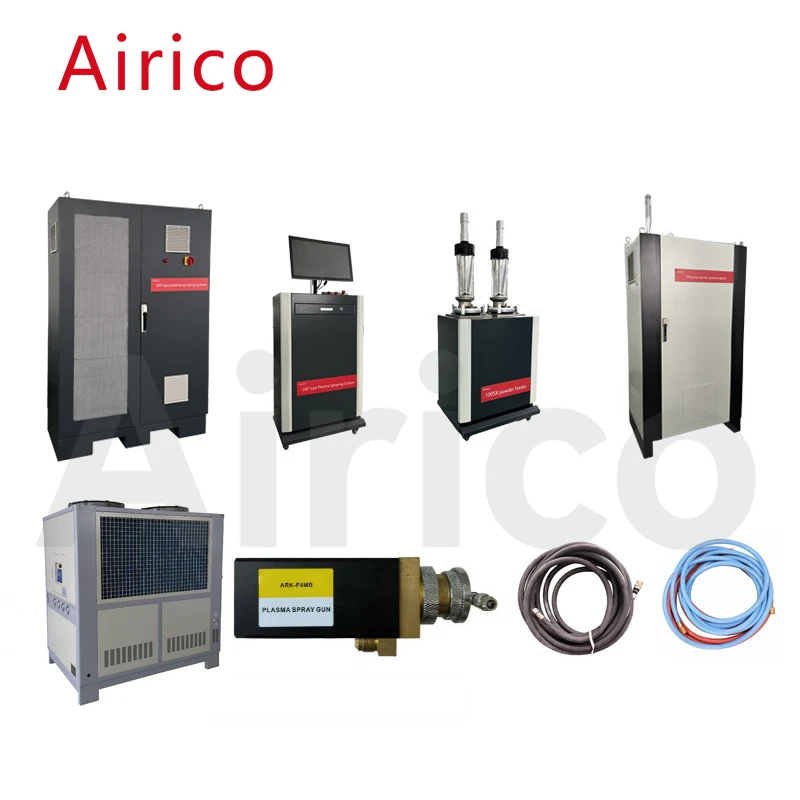Plasma spraying is an advanced surface engineering technique that utilizes a plasma arc as a heat source to melt and deposit various materials onto a substrate surface. This process creates a strong, adherent coating that can enhance the surface properties of the underlying material. The choice of materials used in plasma spraying is crucial and depends on the desired properties of the final coating. Here are some of the most commonly used materials in plasma spraying:

Metals and alloys are among the most widely used materials in plasma spraying due to their excellent mechanical properties and corrosion resistance. These materials can be melted and sprayed onto various substrates to create coatings with desired hardness, wear resistance, and corrosion resistance.
Aluminum (Al): Aluminum is lightweight and possesses good corrosion resistance. Plasma-sprayed aluminum coatings are often used in aerospace and automotive applications where weight reduction is crucial.
Chromium (Cr): Chromium is known for its hardness and corrosion resistance. Plasma-sprayed chromium coatings are used in applications requiring high wear resistance and corrosion protection, such as in the oil and gas industry.
Nickel-Based Alloys: Nickel-based alloys offer excellent corrosion resistance, high-temperature stability, and good mechanical properties. These alloys are commonly used in plasma spraying to create coatings for turbine blades, engine components, and other high-temperature applications.
Ceramics
Ceramic materials are another important category of plasma spraying materials. They are known for their high hardness, wear resistance, and chemical inertness. Ceramic coatings can provide excellent protection against high temperatures, abrasive wear, and chemical attack.
Alumina (Al2O3): Alumina is one of the most commonly used ceramic materials in plasma spraying. It has high hardness, wear resistance, and chemical stability. Alumina coatings are widely used in applications such as wear-resistant surfaces, thermal barriers, and corrosion protection.
Zirconia (ZrO2): Zirconia is another important ceramic material with high hardness and excellent thermal stability. Plasma-sprayed zirconia coatings are used in high-temperature applications, such as in turbine engines and furnace linings.
Silicon Nitride (Si3N4): Silicon nitride offers high hardness, good wear resistance, and low thermal conductivity. It is used in plasma spraying to create coatings for cutting tools, engine components, and other applications requiring high thermal shock resistance.
Composite materials are also used in plasma spraying to combine the best properties of different materials. These composites can offer enhanced mechanical properties, wear resistance, and corrosion protection.
Metal-Ceramic Composites: Metal-ceramic composites combine the hardness and wear resistance of ceramics with the toughness and ductility of metals. These composites are used in plasma spraying to create coatings with excellent mechanical properties and corrosion resistance.
Carbon Fiber Composites: Carbon fiber composites are lightweight and possess high strength and stiffness. Plasma-sprayed carbon fiber coatings are used in aerospace and automotive applications where weight reduction and high performance are critical.
In addition to the above-mentioned materials, plasma spraying can also utilize various other materials tailored for specific applications. For example, oxide ceramics such as chromium oxide (Cr2O3) and titanium dioxide (TiO2) are used in plasma spraying to create coatings for optical applications, such as anti-reflective coatings and protective films.
Moreover, plasma spraying technology is continuously evolving, and new materials are being developed to meet the increasing demands of various industries. Researchers are exploring new materials with enhanced properties, such as high-entropy alloys and nanostructured ceramics, to further improve the performance of plasma-sprayed coatings.
Plasma spraying offers a versatile and effective way to deposit a wide range of materials onto various substrates. The choice of material depends on the specific application requirements, such as wear resistance, corrosion protection, high-temperature stability, and other mechanical properties. By selecting the right material, plasma spraying can significantly enhance the performance and durability of coated components across various industries.

